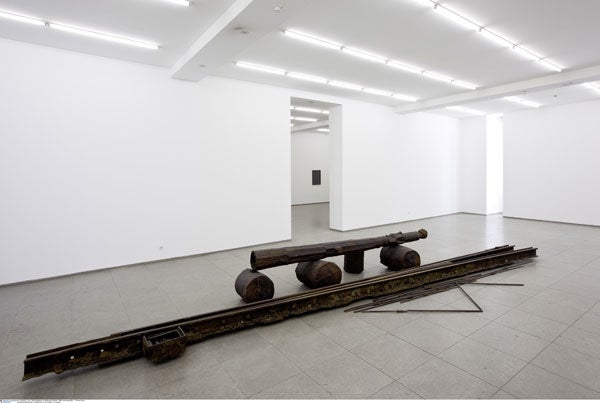Great Works: Tram Stop, 1976, Joseph Beuys
Hamburger Bahnhof, Berlin

Your support helps us to tell the story
From reproductive rights to climate change to Big Tech, The Independent is on the ground when the story is developing. Whether it's investigating the financials of Elon Musk's pro-Trump PAC or producing our latest documentary, 'The A Word', which shines a light on the American women fighting for reproductive rights, we know how important it is to parse out the facts from the messaging.
At such a critical moment in US history, we need reporters on the ground. Your donation allows us to keep sending journalists to speak to both sides of the story.
The Independent is trusted by Americans across the entire political spectrum. And unlike many other quality news outlets, we choose not to lock Americans out of our reporting and analysis with paywalls. We believe quality journalism should be available to everyone, paid for by those who can afford it.
Your support makes all the difference.The narrative of the art of Joseph Beuys, and the multiple keys to its meaning, are utterly at one with the story of his life. This is why no Beuys show is ever quite complete without multiple lugubrious photographs of the man himself, in homburg, braces and long coat, purposefully striding; or of Beuys standing at a blackboard, among a crowd of adoring acolytes, explaining the mysteries of it all with a flurry of quasi-mathematical formulae.
And yet, just occasionally, amid all the racket and the self-heroics of the Beuys travelling show, there are individual works of such brilliance and simplicity that we can do nothing but stop and stare at them. They seem, in part at least, to have come together as if by accident – but is not art often, at least in part, a consequence of luck and material-management?
As so often with Beuys, most of the constituent parts of this sculptural installation are lumpish, crude industrial off-cuts or bits and pieces that seem to be jostling together to gain our attention. Two things are happening in parallel on this particular occasion, one to the right and the other to the left as we stare down at it – and we so often do that with Beuys, stare down at unlovely detritus.
Here we have a fragment of a single-track iron railway track – the title describes it as a tramline. It looks bitten off, wrenched from some other tract of ground, and as it diminishes towards the nearer end, it narrows. Bolts have been driven through it. We see the ends of screws projecting out sideways, quite brutally and matter-of-factly. They make us wince slightly as if this might be a body, flat on the ground, that has been wounded. To the right of that length of tram track, there is a random collection of twenty-two iron stanchions. Almost thrown down, we feel. One of them, separate from the rest, makes a zig-zag formation, as if it has taken it upon itself to become a sudden bolt of lightning. Then, as our eyes shift to the left we begin to feel slightly troubled.
Exactly in parallel with the tram track, a long, makeshift, cylindrical, cannon-like form ends, quite abruptly, in a projecting head with a yawning mouth. Those who wait for trams are usually vertical. They stand on their own two legs. They are the masters of their own human trajectories. This one, by comparison, helpless and horizontal, is on the same plane as the track itself. Yes, it seems to be moving in parallel with the track, dutifully, as if it has no alternative. It is raised up, supported on a few, unevenly spaced, rude, barrel-like forms. When we see a single-track railroad, and even though we know that the artist has named it a Tram Stop – rather blithely, we feel, and perhaps even ironically so – we think of the death camps.
That movement along the same narrow track, the inexorable, unstoppable shuttling back and forth, bringing them all, the helpless of all nations, from wherever it is that they might have been gathered, cowering. This is such a scene we feel, utterly pitiless. And perhaps even more pitiless because this open-mouthed head is nothing but that. There is no more to this body than a head – unless there is the more that we cannot see, bound in some kind of cast-iron mummy cloth, or like the thread bound inside the shuttle of an old-fashioned sewing machine. This human head feels as if it is being speedily processed in the direction of its own destruction. Toppled so unceremoniously like this, it looks weirdly totemic too, as if, like Shelley's "Ozymandias", it once meant much to many, and now means almost less than nothing. It is in motion, or it is just about to be, and it is appealing, open-mouthed, against the movement to which it is being obliged to submit. But we, the downlookers, know the direction in which it is going, and the tramtrack beside it, that too seems to point the way, as if to say: there is only one way forward, and this is it. And what can a headless and once powerful totem do other than to protest, open-mouthed, impotently?
ABOUT THE ARTIST
Joseph Beuys (1921-1986), artist and mythologist of his own life, regarded teaching as his greatest work of art. He encouraged social action, and engaged in much political and philosophical dialogue with the young. Open discourse was his rallying cry, and the unleashing of creativity everywhere his ultimate goal. Part shaman, he encouraged an anarchic, anti-authoritarian regime to flourish wherever he taught – provided that the authority to be challenged did not necessarily include himself. His works often consist of large-scale installations that make use of industrial detritus. His favourite materials were grease and felt.
Join our commenting forum
Join thought-provoking conversations, follow other Independent readers and see their replies
0Comments